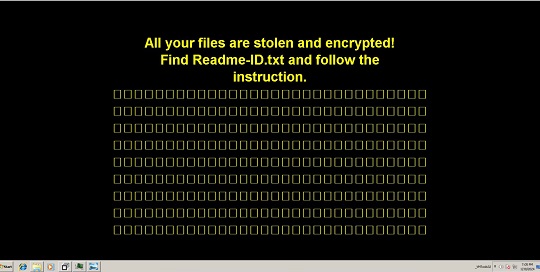Ransom.MSIL.HAKUNAMATATA.THAAFBD
Trojan-Ransom.FileCrypter (IKARUS)
Windows

Tipo di minaccia informatica:
Ransomware
Distruttivo?:
No
Crittografato?:
No
In the wild::
Sì
Panoramica e descrizione
It arrives on a system as a file dropped by other malware or as a file downloaded unknowingly by users when visiting malicious sites.
Dettagli tecnici
Detalles de entrada
It arrives on a system as a file dropped by other malware or as a file downloaded unknowingly by users when visiting malicious sites.
Instalación
Crea las siguientes copias de sí mismo en el sistema afectado y las ejecuta:
- %AppDataLocal%\rundll32.exe
Técnica de inicio automático
Agrega las siguientes entradas de registro para permitir su ejecución automática cada vez que se inicia el sistema:
HKEY_CURRENT_USER\SOFTWARE\Microsoft\
Windows\CurrentVersion\Run
Readme-ID-{Computer Name} = %AppDataLocal%\rundll32.exe
Otras modificaciones del sistema
Este malware establece la imagen siguiente como fondo de escritorio del sistema:
- %User Temp%\{9 Random Characters}.jpg

Finalización del proceso
Finaliza los procesos siguientes si detecta que se ejecutan en la memoria del sistema afectado:
- CNTAoSMgr
- code
- dbeng50
- dbsnmp
- encsvc
- excel
- firefoxconfig
- infopath
- isqlplussvc
- mbamtray
- msaccess
- msftesql
- mspub
- mydesktopqos
- mydesktopservice
- mysqld
- mysqld-nt
- mysqld-opt
- Ntrtscan
- ocautoupds
- ocomm
- ocssd
- onenote
- oracle
- outlook
- PccNTMon
- powerpnt
- ProcessHacker
- sqbcoreservice
- sqlagent
- sqlbrowser
- sqlservr
- sqlwriter
- steam
- synctime
- tbirdconfig
- thebat
- thebat64
- thunderbird
- tmlisten
- VBoxSVC
- VirtualBoxVM
- visio
- vmplayer
- winword
- wordpad
- wps
- xfssvccon
- zoolz
Otros detalles
Hace lo siguiente:
- It checks if its process file path and file name is %AppDataLocal%\rundll32.exe
- If not, it checks if %AppDataLocal%\rundll32.exe already exists
- If it exists, it will delete the file and drops a copy of itself as %AppDataLocal%\rundll32.exe.
- If not, it will drop a copy of itself as %AppDataLocal%\rundll32.exe.
- If not, it checks if %AppDataLocal%\rundll32.exe already exists
- It checks if the size of the file to encypt is less than or greater than 524,288 bytes
- If it is less than 524,288 bytes, it will encrypt the whole file.
- If it is greater than 524,288 bytes, it will use intermittent encryption - First 131,072 bytes, another 131,072 bytes from the middle of the file, and the last 131,072 bytes
- It empties the recycle bin
- It encrypts its targeted files twice.
Soluzioni
Step 2
Los usuarios de Windows ME y XP, antes de llevar a cabo cualquier exploración, deben comprobar que tienen desactivada la opción Restaurar sistema para permitir la exploración completa del equipo.
Step 3
Note that not all files, folders, and registry keys and entries are installed on your computer during this malware's/spyware's/grayware's execution. This may be due to incomplete installation or other operating system conditions. If you do not find the same files/folders/registry information, please proceed to the next step.
Step 4
Reiniciar en modo seguro
Step 5
Eliminar este valor del Registro
Importante: si modifica el Registro de Windows incorrectamente, podría hacer que el sistema funcione mal de manera irreversible. Lleve a cabo este paso solo si sabe cómo hacerlo o si puede contar con ayuda de su administrador del sistema. De lo contrario, lea este artículo de Microsoft antes de modificar el Registro del equipo.
- In HKEY_CURRENT_USER\SOFTWARE\Microsoft\Windows\CurrentVersion\Run
- Readme-ID-{Computer Name} = %AppDataLocal%\rundll32.exe
- Readme-ID-{Computer Name} = %AppDataLocal%\rundll32.exe
Step 6
Buscar y eliminar estos archivos
- %AppDataLocal%\rundll32.exe
- {Encrypted Directory}\Readme-ID-{Computer Name}.txt
- %User Temp%\{9 Random Characters}.jpg
- %AppDataLocal%\rundll32.exe
- {Encrypted Directory}\Readme-ID-{Computer Name}.txt
- %User Temp%\{9 Random Characters}.jpg
Step 7
Reinicie en modo normal y explore el equipo con su producto de Trend Micro para buscar los archivos identificados como Ransom.MSIL.HAKUNAMATATA.THAAFBD En caso de que el producto de Trend Micro ya haya limpiado, eliminado o puesto en cuarentena los archivos detectados, no serán necesarios más pasos. Puede optar simplemente por eliminar los archivos en cuarentena. Consulte esta página de Base de conocimientos para obtener más información.
Step 8
Restore encrypted files from backup.
Sondaggio

